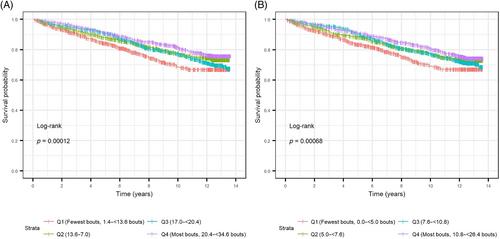Breaking Up Sedentary Time Reduces Recurrent Fall Risk, but Not Incident Fracture Risk in Older Men
Lauren S. Roe, Stephanie Harrison, Peggy M. Cawthon, Kristine Ensrud, Kelley Pettee Gabriel, Deborah M. Kado, Jane A. Cauley, the Osteoporotic Fractures in Men (MrOS) Study Research Group
下载PDF
{"title":"Breaking Up Sedentary Time Reduces Recurrent Fall Risk, but Not Incident Fracture Risk in Older Men","authors":"Lauren S. Roe, Stephanie Harrison, Peggy M. Cawthon, Kristine Ensrud, Kelley Pettee Gabriel, Deborah M. Kado, Jane A. Cauley, the Osteoporotic Fractures in Men (MrOS) Study Research Group","doi":"10.1002/jbm4.10803","DOIUrl":null,"url":null,"abstract":"<p>Apart from physical activity volume, frequent breaks from sedentary bouts and active bouts may differentially reduce fall and fracture risk. We assessed the longitudinal relationship between frequency of breaks from time spent sedentary and frequency of active bouts with recurrent falls and fractures. The sample included 2918 men aged 79.0 ± 5.1 years with free-living activity (SenseWear Armband) at the Osteoporotic Fractures in Men Study (MrOS) year 7 (2007–2009) visit. Men were divided into quartiles by the number of breaks from sedentary bouts (sedentary bout: 5+ minutes sedentary; <1.5 metabolic equivalents of task [METS]) and separately by active bout frequency (active bout: 5+ minutes of activity; ≥1.5 METS). Recurrent falls (2+ falls/year) and fractures were ascertained by self-report; fractures were radiographically confirmed. Generalized estimating equations estimated the recurrent fall odds, with restricted cubic splines applied to assess nonlinear relationships. Cox proportional hazards models estimated fracture risk. Over 4 years of follow-up after year 7, 1025 (35.1%) men were fallers. Over 8.40 ± 4.10 years of follow-up, 640 (21.9%) men experienced a fracture. There was a significant nonlinear U-shaped relationship between number of breaks from sedentary bouts and recurrent falls (<i>p</i> < 0.001); compared with men with few breaks from sedentary bouts (1.4–<13.6), the odds of recurrent falls were lower with a moderate number (13.6–<17.0, odds ratio [OR] = 0.82, 95% confidence interval [CI] 0.66, 1.01; 17.0–<20.4, OR = 0.79, 95% CI 0.64, 0.99), but not with the highest number of breaks from sedentary bouts (20.4–34.6, OR = 1.01, 95% CI 0.81, 1.27). Results remained borderline significant after adjusting for total sedentary time. Men with the highest compared with the lowest number of breaks from sedentary bouts had a lower fracture risk, but the association was attenuated after adjustment for total sedentary time. No associations were observed for active bout frequency. In conclusion, breaking up extended periods of sedentary time reduces fall risk regardless of total sedentary time. © 2023 The Authors. <i>JBMR Plus</i> published by Wiley Periodicals LLC. on behalf of American Society for Bone and Mineral Research.</p>","PeriodicalId":14611,"journal":{"name":"JBMR Plus","volume":"7 12","pages":""},"PeriodicalIF":3.4000,"publicationDate":"2023-08-07","publicationTypes":"Journal Article","fieldsOfStudy":null,"isOpenAccess":false,"openAccessPdf":"https://asbmr.onlinelibrary.wiley.com/doi/epdf/10.1002/jbm4.10803","citationCount":"0","resultStr":null,"platform":"Semanticscholar","paperid":null,"PeriodicalName":"JBMR Plus","FirstCategoryId":"1085","ListUrlMain":"https://onlinelibrary.wiley.com/doi/10.1002/jbm4.10803","RegionNum":0,"RegionCategory":null,"ArticlePicture":[],"TitleCN":null,"AbstractTextCN":null,"PMCID":null,"EPubDate":"","PubModel":"","JCR":"Q2","JCRName":"ENDOCRINOLOGY & METABOLISM","Score":null,"Total":0}
引用次数: 0
引用
批量引用
Abstract
Apart from physical activity volume, frequent breaks from sedentary bouts and active bouts may differentially reduce fall and fracture risk. We assessed the longitudinal relationship between frequency of breaks from time spent sedentary and frequency of active bouts with recurrent falls and fractures. The sample included 2918 men aged 79.0 ± 5.1 years with free-living activity (SenseWear Armband) at the Osteoporotic Fractures in Men Study (MrOS) year 7 (2007–2009) visit. Men were divided into quartiles by the number of breaks from sedentary bouts (sedentary bout: 5+ minutes sedentary; <1.5 metabolic equivalents of task [METS]) and separately by active bout frequency (active bout: 5+ minutes of activity; ≥1.5 METS). Recurrent falls (2+ falls/year) and fractures were ascertained by self-report; fractures were radiographically confirmed. Generalized estimating equations estimated the recurrent fall odds, with restricted cubic splines applied to assess nonlinear relationships. Cox proportional hazards models estimated fracture risk. Over 4 years of follow-up after year 7, 1025 (35.1%) men were fallers. Over 8.40 ± 4.10 years of follow-up, 640 (21.9%) men experienced a fracture. There was a significant nonlinear U-shaped relationship between number of breaks from sedentary bouts and recurrent falls (p < 0.001); compared with men with few breaks from sedentary bouts (1.4–<13.6), the odds of recurrent falls were lower with a moderate number (13.6–<17.0, odds ratio [OR] = 0.82, 95% confidence interval [CI] 0.66, 1.01; 17.0–<20.4, OR = 0.79, 95% CI 0.64, 0.99), but not with the highest number of breaks from sedentary bouts (20.4–34.6, OR = 1.01, 95% CI 0.81, 1.27). Results remained borderline significant after adjusting for total sedentary time. Men with the highest compared with the lowest number of breaks from sedentary bouts had a lower fracture risk, but the association was attenuated after adjustment for total sedentary time. No associations were observed for active bout frequency. In conclusion, breaking up extended periods of sedentary time reduces fall risk regardless of total sedentary time. © 2023 The Authors. JBMR Plus published by Wiley Periodicals LLC. on behalf of American Society for Bone and Mineral Research.
打破久坐时间可以降低老年男性复发性跌倒的风险,但不会降低意外骨折的风险
除了身体活动量外,经常从久坐和活跃的运动中休息可以不同地减少跌倒和骨折的风险。我们评估了久坐时间的休息频率与复发性跌倒和骨折的活动发作频率之间的纵向关系。样本包括2918名男性,年龄79.0±5.1岁,在男性骨质疏松性骨折研究(MrOS)第7年(2007-2009)访问期间有自由生活活动(SenseWear臂章)。根据久坐的休息时间将男性分成四分之一(久坐:5分钟以上;<1.5代谢当量任务[METS]),并分别按运动频次(运动频次:5+分钟;≥1.5大都会)。复发性跌倒(2+跌倒/年)和骨折通过自我报告确定;骨折经x线片证实。广义估计方程估计了反复下降的几率,用限制三次样条来评估非线性关系。Cox比例风险模型估计了骨折风险。在7年后的4年随访中,1025名(35.1%)男性出现了下降。在8.40±4.10年的随访中,640名(21.9%)男性发生骨折。久坐休息次数与复发性跌倒之间存在显著的非线性U形关系(p < 0.001);与久坐很少休息的男性相比(1.4 - <13.6),复发跌倒的几率较低,次数适中(13.6 - <17.0),优势比[OR] = 0.82, 95%可信区间[CI] 0.66, 1.01;17.0 - <20.4, OR = 0.79, 95% CI 0.64, 0.99),但与久坐运动的休息次数无关(20.4 - 34.6,OR = 1.01, 95% CI 0.81, 1.27)。在调整了总久坐时间后,结果仍然是临界显著的。久坐休息次数最多的男性与久坐休息次数最少的男性相比,骨折风险更低,但在调整了总久坐时间后,这种关联减弱了。未观察到与活跃回合频率相关。总之,抛开久坐时间长短不谈,打破长时间的久坐可以降低跌倒的风险。©2023作者。JBMR Plus由Wiley期刊有限责任公司代表美国骨与矿物研究协会出版。
本文章由计算机程序翻译,如有差异,请以英文原文为准。



